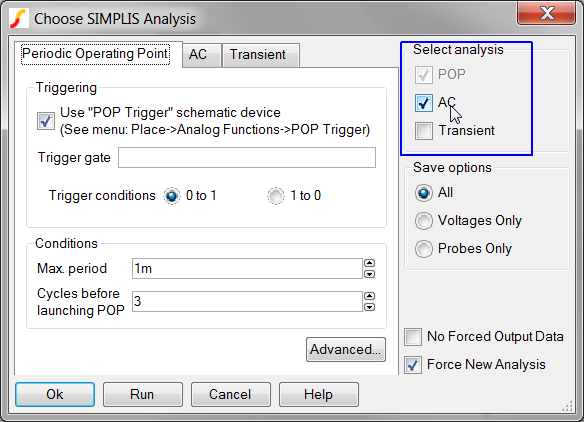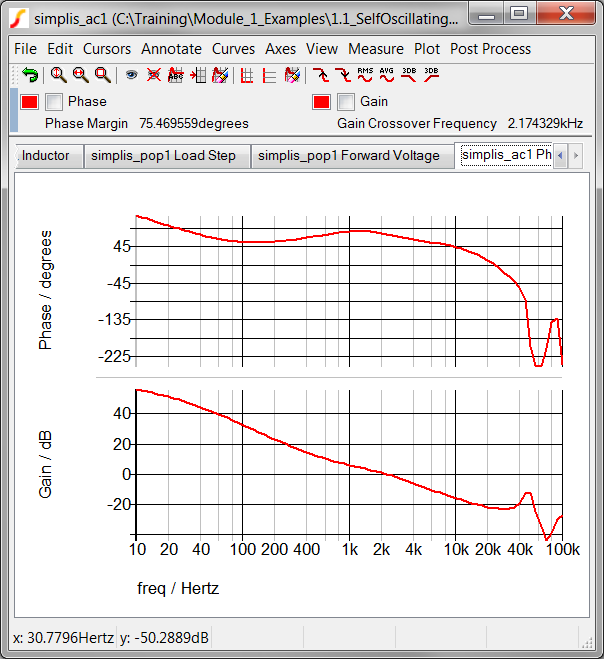Advanced SIMPLIS Training
|
In this Topic Hide
How SIMPLIS simulates the AC response of a time domain model.
The difference between the AC results on a time-domain model and an averaged model.
If the graph viewer is open, close it.
Open the schematic titled 1.1_SelfOscillatingConverter_POP_AC_Tran.sxsch.
From the schematic menu, select Simulator Choose Analysis...
Un-check all analysis check boxes, and check the AC analysis
checkbox.
Result: The POP Checkbox is also checked,
but disabled - indicating you must run a POP analysis before every
AC analysis.
The dialog should appear as follows:

Click Run.
Result: SIMPLIS runs a POP analysis followed
by an AC analysis on the Self Oscillating Converter. As with the last
section, the graph viewer opens with 3 switching cycles of data, but
also with the AC response of the control loop. As is the case here,
when only POP and AC results are requested, the POP results are displayed
first and the AC results are displayed on the rightmost tab. When
POP, AC and Transient results are requested, then the AC results appear
first on the leftmost tab, followed by the Transient waveforms.

When you go into the lab and connect your switching power system to a network analyzer, you are measuring the AC response of the circuit in the time domain. Your circuit doesn't suddenly change to a averaged small signal model when the network analyzer is connected to it. The SIMPLIS AC analysis works exactly in the same way; it performs an AC analysis on a time-domain simulation model.
You run a POP analysis on the circuit. This finds the large signal steady state operating point of the circuit.
You run an AC analysis on the circuit. For each frequency in the sweep, the AC analysis does the following:
Sets all AC sources(for AC analysis) to a common frequency - the analysis frequency. The analysis frequency is not the switching frequency where the POP analysis took place - it is the frequency of the AC source(s) (for AC analysis) in the circuit.
These AC sources are time-domain sinusoidal, and the amplitudes of each source is set to an infinitesimally small number.
SIMPLIS simulates the time domain response of the circuit to the AC perturbation.
Using Fourier methods, SIMPLIS extracts the small signal response of the circuit from the time-domain data.
During an AC sweep, steps a-d above are repeated for each frequency in the sweep. The circuit is perturbed by a single frequency, and that frequency is stepped.
If the circuit does not POP successfully, in other words, if SIMPLIS cannot find a stable steady-state periodic operating point, the AC analysis will not be run. A warning message appears in the shell.
Your circuit may converge during the POP analysis, but to a periodic operating point which you are not expecting. A common example occurs when the circuit converges in a current limit or other fault condition. Since during current limit operation, the voltage loop is essentially open, the gain of the voltage loop is greatly attenuated.
|
© 2015 simplistechnologies.com | All Rights Reserved